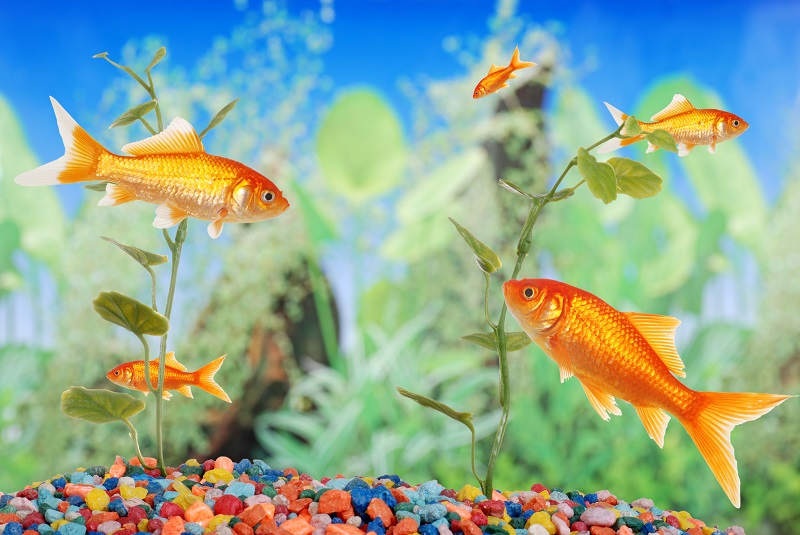Not only will cold-water fish add colour and tranquility to your home, they are also easy to care for and, if monitored carefully, can live long and healthy lives. Learn how to look after your finned friends with this handy guide.

Cold-water fish fact file
Life span – Indoor: Up to 10 years, Outdoor: Up to 20 years
Size – Indoor: Up to 30cm, Outdoor: Up to 20 years
Diet – Fish pellets or flakes
Home – Tank or pond – 35-50 litres per fish
Care and maintenance
Cold-water fish brighten up an indoor tank and they can enjoy their lives in an outdoor pond as well. Neon, tetra, and danios are popular breeds to live in an indoor tank, while koi and goldfish that can grow larger and live longer are a perfect choice for your outdoor pond.
Whether you have an outdoor or indoor aquarium, your pets’ new home will need to meet specific requirements. With testing kits and tools that you can find at your local Petbarn it’s easy to maintain a stabilised tank.
- Temperature: Between 15°C and 20°C.
- pH: Between 6.8 and 7.8.
- Nitrite: Below 0.5ppm, 0 being perfect.
- Nitrate: Below 40ppm, with 0 being ideal.
Depending on the breed of fish you are caring for, these levels are subject to change. Talk to your local Petbarn team member about stabilising water for your chosen breed of cold-water fish.
Setting up
Cold-water fish need a spacious tank to live comfortably and the size of your tank will depend on how many fish you would like to keep. Talk to your local Petbarn team member to decide on what size tank is appropriate.
Once you have your tank in place – avoiding heaters and full sun exposure – place your substrate inside. Gravel is a great option that’s also very easy to clean.
If your pets will live in an outdoor pond, line it with plants, underwater toy boat wrecks or pre-treated logs for them to enjoy. Different breeds are happy with different plants, so talk to your local Petbarn team member about the perfect plants for your pond.
Before you welcome your fish into their new home, cycle your aquarium for at least a week. This will ensure the water is clean, at the perfect temperature for its new inhabitants and allows good bacteria to form.
A water filter and thermometer will maintain water quality – you can even take some of the water to your local Petbarn to be tested.
Feeding
Feed your fish specialised pellets or flakes. These are easy to find at your local Petbarn. A common cause of death in fish is overeating. Feed both indoor and outdoor fish types no more than they can eat in less than five minutes.
Fish in outdoor ponds feed off their ecosystem but will still need flakes or pellets. If they eat their food quickly, they are likely underfed. In this case, feed them once a day until they seem to be less interested. Then phase it out to once a week.
Cleaning
Regularly change the water in your aquarium to keep it clean. Do this by removing only 25% of the water at a time. When replacing water, make sure it’s the right temperature and free of any chemicals. Use a siphon to remove any unwanted matter that is floating around.
Whether indoor or outdoor, all aquariums are prone to producing algae. For indoor aquariums, it’s worth investing in an algae scraper or magnetic glass cleaner.
If you’re finding algae in your pond, remove any plants that might be crowding. You could also introduce a new organism into your pond – an algae eater. Snails are the most common choice, as they are particularly skilled at removing algae.
Fish types – compatibility
Housing incompatible fish together can cause stress, disease and injury. Be sure to do your research and chat to your local Petbarn team member to get an insight into breeds that will peacefully coexist.
Compatible indoor cold-water fish species:
- Goldfish
- Bloodfin tetras
- Betta
- Platies
- Danios
Compatible outdoor cold-water fish species:
- Goldfish
- Koi
- Native fish (types will depend your state)
- Snails
Health care
Before deciding on your new fish, make sure they don’t have any ailments or injuries. An unhealthy fish will find it a lot harder to adjust to their new home and will have a much shorter life span. Check your fish once a day to make sure they are in top condition and thriving in their aquarium.
Cold-water fish are prone to fungal infections and internal parasites. Look out for any physical changes in your fish – changes in colour, spots, bulging eyes or swelling are signs your fish may have a serious ailment that, if not treated, could infect the rest of the tank.
If you notice anything out of the ordinary about your fish, make sure to visit your local Greencross Vets.
Pet safety tips
Keep your tank in a high, stable position clear from any overexposure to sunlight, air conditioning or heating.
If you notice anything abnormal about your fish, they may have an infection or be being bullied. It’s recommended you have a quarantine tank, with cycled water, to house the affected fish in order to resolve any social disruptions or reduce the spread of infection.
If one of your cold-water fish has contracted an infection the whole tank could be at risk. You will need to take measures to protect your other fish by disinfecting the tank. Refer to your local Petbarn for advice and products you’ll need.
Tip: Check your water regularly to ensure it’s in top condition
Cold-water fish checklist
Tick each item off your fish supplies checklist at Petbarn online or in-store.
